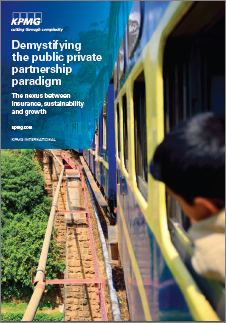KPMG: Demystifying the public private partnership paradigm
July 28 2015
With the insurance industry continuing to play a more active role in helping the world respond to seemingly intractable global challenges such as climate change, disaster resilience and economic sustainability, insurers are cultivating new and innovative partnership agreements – including Public Private Partnership (PPP) models – with non-traditional players and organisations to help close the protection gap.
For most, the development of these types of partnerships and initiatives will require new ways of thinking. New business models, new ideas, new relationships and new technologies will all be required to create strong and sustainable PPPs; insurers will need to break new ground if they hope to have a sustainable impact in this area.
As this report illustrates, there are clear and measurable upsides to helping reduce global risk and enhancing resilience. Indeed, PPPs are not about funneling charity dollars to development projects; it is about creating win-win business models with new partners in order to drive future growth, reduce risk and inspire innovation.
The insurance industry has a fundamental and central role to play in the global response to issues such as climate change, natural catastrophes, financial inclusion and sustainability. But, for solid progress to be made, policymakers, intermediaries, development organisations and regulators will need to update their understanding of the role that insurers can (and should) play.
-
QBE’s Hammond on transformation and growth
- July 2
The Asia chief executive discusses Covid-19, going digital and restructuring.
-
Swiss Re: Nat cats and man-made disasters in 2018
- April 10
Climate change, increased urbanisation and a growing concentration of assets were on the risk agenda for 2018.
-
Willis Towers Watson: 2019 Asia Market Report
- March 19
Economic uncertainty, more complex risks and tighter underwriting are all influencing Asia's markets.
-
Peak Re: Emerging Asia’s life and health opportunity
- March 11
Life and health premium growth is expected to outpace GDP gains in eight Asian markets.
-
Allianz General | Allianz General combines innovative protection solutions while powering social good to lead Malaysian market
The carrier proactively addresses emerging risks and evolving customer protection needs while giving back to the community.
-
Sedgwick | Asia’s Energy Transformation – Balancing Growth, Risk and Renewables
Energy market presents unique risks, especially in a region which includes China and Japan as well as developing nations like Vietnam and the Philippines.
-
Beazley | Turbulent Waters: the maritime energy transition challenge
Businesses are facing a complex transition to non-carbon energy sources amid a push to achieve net-zero emissions for the marine sector by 2050.
-
Aon | Navigating shifts in the global and Asia insurance markets
Neelay Patel, Aon head of growth for Asia, says the market in Asia is at an ‘interesting stage of the cycle’.

